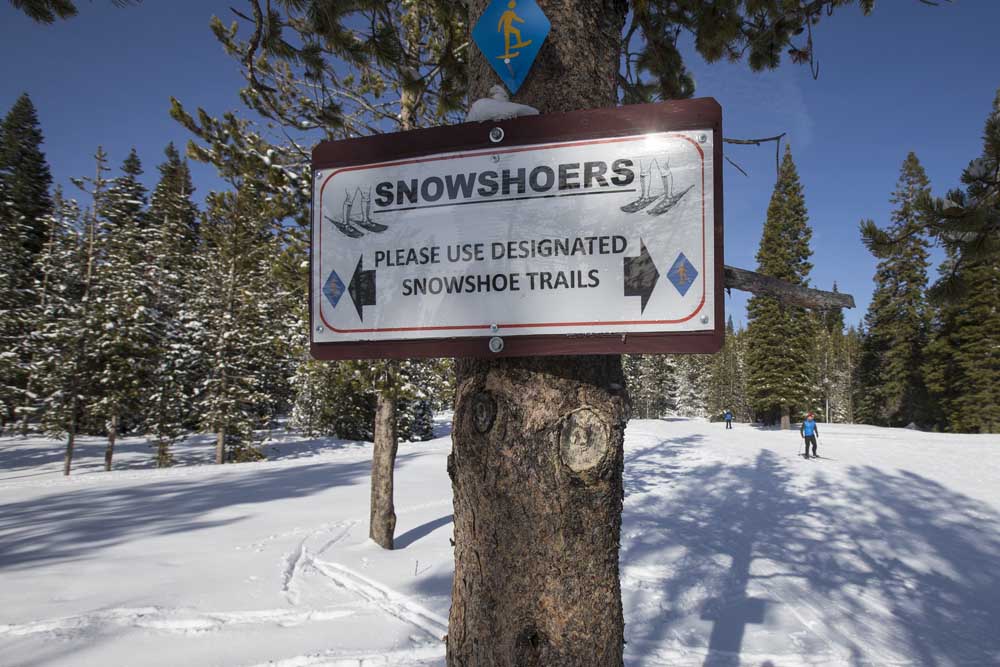Etiquette crucial at Central Oregon’s crowded sno-parks
Published 4:00 am Friday, January 15, 2021

- A sign reminds snowshoers to use the designated trails at Virginia Meissner Sno-park.
A combination of the COVID-19 pandemic, an ample snowpack and limited parking at Mt. Bachelor ski area has created a crush of crowds at Central Oregon sno-parks this winter.
“The outdoors around here has always been cherished, but now more than ever, it’s intensely loved, and it creates extreme peak use, congestion and overflow situations that can tend to surprise people,” said Scott McBride, recreation manager for the Bend-Fort Rock Ranger District of the Deschutes National Forest.
Trending
“If you show up at a peak day at a peak time, you can certainly count on peak crowds, and potentially nowhere to park at multiple sites.”
Outdoor enthusiasts looking to cross-country ski, snowshoe, snowmobile, fatbike or sled would be wise to follow the parking rules, avoid peak times and adhere to proper etiquette when using the groomed trails that emanate from the sno-parks.
Wanoga, Virginia Meissner and Dutchman Flat sno-parks west of Bend off Century Drive have all been extremely busy, McBride said, as has 10-Mile Sno-park east of La Pine in the Newberry National Volcanic Monument. McBride suggested arriving at a sno-park right as the sun is coming up. There will be fewer crowds, and it is an extra beautiful, quiet time of the day.
But Gary Meyer, who grooms the 11 miles of fatbike trails at Wanoga, noted that many people do not like to rise early.
“So go up there at about 4 p.m., with lights on your bike, or headlamp for skiing and go in the evening,” Meyer recommended. “You don’t need super bright lights, between 300 and 700 lumens is all you need.” Meyer described the Christmas holiday crowds at Wanoga as “off-the-charts nutty.”
“And this past weekend, by 9:30 a.m., all the legal spaces in the lot were full,” Meyer said. “By 11:30, everybody was parking illegally, parallel parked along the oval or along the access road.” McBride said that vehicles illegally parked at “No Parking” signs have been a problem this winter at sno-parks.
Trending
“Some vehicles are too big to navigate an exit, and we need space for emergency vehicles,” McBride said. “We’re having some significant issues with disregard for what the signs are asking. When the site’s full, it’s full. That’s a concept that can be difficult to embrace when you have it set in your mind, ‘I am going to that sno-park and I am doing this trail.’ Well, have some contingencies in case it’s full. Or go earlier.”
Encounters among user groups at sno-parks are perhaps less of an issue than parking, but if folks know some of the basic rules and proper etiquette ahead of time they will likely enjoy their time there more.
The Deschutes National Forest trail conditions report has crucial information about motorized and nonmotorized use, as well as where dogs are allowed. Skiers, snowshoers and fatbikers that hear a snowmobile coming should be prepared to yield.
“Those that are not on the snowmobile can hear it coming,” McBride said. “Those that are on the snowmobile may not see and hear someone not on a snowmobile. If you’re coming around a corner or in a blind spot, you need to make sure you’re not in the snowmobile’s path.”
For nonmotorized areas, such as Meissner Sno-park, signs indicate whether the trails are for snowshoeing or skiing. Snowshoers are supposed to stay off the groomed ski trails, especially the classic tracks.
“They could get stomped out by snowshoe tracks,” said Larry Katz, operations manager for Meissner Nordic, the nonprofit that grooms ski trails at the sno-park each winter. Katz added that nordic skiers should yield to the skier going downhill.
“Most of the trails are wide enough that there’s not problem,” Katz said. “Step out of the tracks, the person goes by, then step back in.”
According to Meyer, at Wanoga, fatbikers generally yield to other user groups because they have brakes and can stop more easily. Snowshoers and skiers are allowed on the fatbike trails, and fatbikers are allowed on snowshoe trails and groomed snowmobile trails. Fatbiking is prohibited on groomed nordic ski trails.
“We have brakes, and it’s pretty easy to stop,” Meyer said of fatbikers. “But they (snowshoers) need to step off the trail. Because snowshoes won’t sink into the deep snow, but we will.” Meyer noted that fatbiking at Wanoga has increased by about 50% since last winter. (Fatbikes are essentially mountain bikes with wider tires that can handle groomed or packed snow.)
Even with the increased crowds at area sno-parks, finding solitude in the Deschutes National Forest does not take long.
“As soon as you get away from the parking lot, just even 500 feet away, it’s a peaceful, normal, wonderful experience,” Meyer said. “You can spend hours out there riding or skiing and really not run into that many people at all.”








